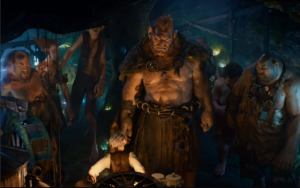Metro In Focus: How Steven Spielberg brought the Big Friendly Giant to life
 By Richard Crouse – Metro In Focus
By Richard Crouse – Metro In Focus
If you are not a Roald Dahl fan the term The BFG almost sounds like something you might call someone you don’t like.
If you’re familiar with the Dahl’s work, stories like James and the Giant Peach, Charlie and the Chocolate Factory, Matilda and Fantastic Mr Fox, you’ll already know The BFG stands for The Big Friendly Giant.
Just in time for the 100th anniversary of Dahl’s birth, Steven Spielberg brings the towering tale of an orphan girl who befriends a taller-than-tall giant to the big screen.
Mark Ryland, last year’s best supporting Oscar winner for Bridge of Spies, plays the BFG but he’s not the film’s only leviathan. Giant Country is filled with “cannybully and murderful” goliaths with fanciful names like The Childchewer and The Gizzardgulper.
They are the BFG’s brothers, behemoths so huge if six-foot eight-inch Cleveland Cavaliers forward Lebron James stood next to them he’d only come up to their ankle. They’re fearsome but Meatdripper portrayer Paul Moniz de Sa is quick mention, “There’s still a lot of joy in the giants.”
“We were going more for goose bumps,” says Michael Adamthwaite who plays the Butcher Boy. “The film does a good job of showing [kids] how to overcome that fear and finding confidence and being brave and standing up for what you believe in.”
Creating a world for the giants to inhabit involved groundbreaking technology to blend the live-action elements with performance-capture techniques. The richly detailed Giant Country, where swords are used as sewing needles and sailing ships double as beds, was brought to vivid life on soundstages in Vancouver last year.
“It was a big empty space and you had to use your imagination to feel the different elements,” says Daniel Bacon who plays Bonecruncher. “There was tape on the floor and it was explained that something would be here, and something would be there. We relied on Steven telling us and being very descriptive about what it would look like.”
“We also had the wonderful concept art to fall back on,” says Adamthwaite. “For all the locations there was a big concept art poster and then there was the virtual camera which is technologically way beyond my brain power, but it is so crisp and the technology has advanced so quickly that now we are at a point that even though we were in a carpeted room with tape on the floor we had the benefit of being able to look over to a large screen monitor and see these almost real time, almost full renderings of our characters.”
The result of the high tech work is a film that has so little to do with today’s kid’s entertainment it feels as though it’s a relic from another time, a singular holdover from a day before Minions gurgled and everything was awesome. Adamthwaite credits Spielberg for finding the right tone.
“While some directors may be pushing the boundaries of being cutting edge. He always sees the film through the audience’s eyes. He’s very aware and astute of what will work in terms of what the audience appreciates.”
